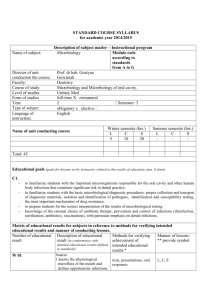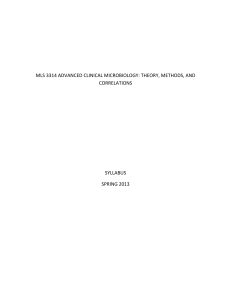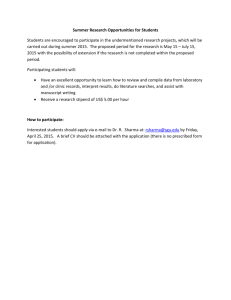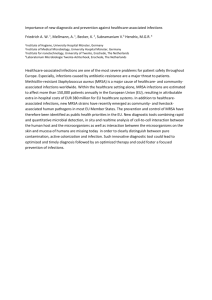Microbiology & Oral Microbiology Syllabus - Dentistry Program
advertisement
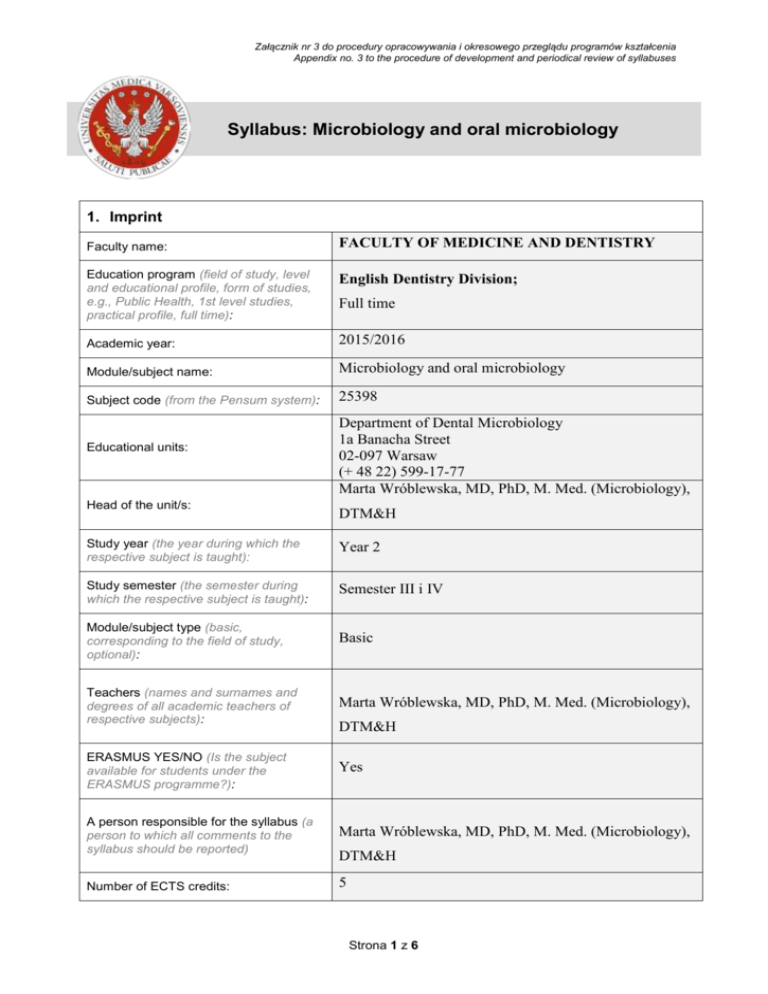
Załącznik nr 3 do procedury opracowywania i okresowego przeglądu programów kształcenia Appendix no. 3 to the procedure of development and periodical review of syllabuses Syllabus: Microbiology and oral microbiology 1. Imprint Faculty name: FACULTY OF MEDICINE AND DENTISTRY Education program (field of study, level and educational profile, form of studies, e.g., Public Health, 1st level studies, practical profile, full time): English Dentistry Division; Academic year: 2015/2016 Module/subject name: Microbiology and oral microbiology Subject code (from the Pensum system): 25398 Educational units: Head of the unit/s: Full time Department of Dental Microbiology 1a Banacha Street 02-097 Warsaw (+ 48 22) 599-17-77 Marta Wróblewska, MD, PhD, M. Med. (Microbiology), DTM&H Study year (the year during which the respective subject is taught): Year 2 Study semester (the semester during which the respective subject is taught): Semester III i IV Module/subject type (basic, corresponding to the field of study, optional): Basic Teachers (names and surnames and degrees of all academic teachers of respective subjects): Marta Wróblewska, MD, PhD, M. Med. (Microbiology), ERASMUS YES/NO (Is the subject available for students under the ERASMUS programme?): Yes A person responsible for the syllabus (a person to which all comments to the syllabus should be reported) Marta Wróblewska, MD, PhD, M. Med. (Microbiology), Number of ECTS credits: 5 DTM&H DTM&H Strona 1 z 6 Załącznik nr 3 do procedury opracowywania i okresowego przeglądu programów kształcenia Appendix no. 3 to the procedure of development and periodical review of syllabuses 2. Educational goals and aims The main objectives of the course are to teach the students: • the characteristics of main human pathogens • laboratory diagnostic methods • principles of sterilisation and disinfection in dental practice • pathogenesis and epidemiology of infectious diseases • defence mechanisms against infections • physiological flora of the oral cavity • pathogenesis and microbiology of dental caries • microbiology of periodontal disease • systemic odontogenic infections • chemotherapy of bacterial, fungal and viral infections • prophylaxis of infectious diseases • infection control in dental practice 3. Initial requirements Not applicable 4. Learning outcomes corresponding to the subject A list of course learning outcomes Symbol of course learning outcomes Description of course learning outcomes The reference to programme learning outcomes (number) 25094 C.W1 knows genera, species and structure of viruses, bacteria and fungi, their biological properties and pathomechanisms 25094 C.W1 25094 C.W2 knows and describes bacterial physiological flora of humans 25094 C.W2 25094 C.W3 knows and understands basic epidemiology of bacterial, viral and fungal infections, and routes of their spread in the host 25094 C.W3 25094 C.W4 knows species of bacteria, viruses and fungi, which are the most common etiological agents of infections 25094 C.W4 25094 C.W5 knows the basics of disinfection, sterilisation and aseptics 25094 C.W5 25094 C.W6 knows external and internal pathogens 25094 C.W6 25094 C.W9 knows and understands the phenomenon of microbial resistance to antimicrobial agents 25094 C.W9 25094 C.W20 knows and understands principles of therapy of bacterial, viral and fungal infections 25094 C.W20 25094 C.U1 collects properly selected clinical samples for 25094 C.U1 Strona 2 z 6 Załącznik nr 3 do procedury opracowywania i okresowego przeglądu programów kształcenia Appendix no. 3 to the procedure of development and periodical review of syllabuses microbiological tests depending on the site and course of the infection 25094 C.U2 correctly interprets the results of microbiological and serological tests as well as antimicrobial susceptibility tests 25094 C.U2 25094 C.U3 selects and performs proper tests for quantitative evaluation of bacterial counts in body fluids 25094 C.U3 5. Forms of classes Form Number of hours Number of groups Lecture 10 1 Seminar 15 1 Practical classes 45 2 6. Subject topics and educational contents W1. Pathogenesis and epidemiology of bacterial infections of the oral cavity. 25094 C.W2; 25094 C.W3; 25094 C.W6; 25094 C.U3 W2. Anaerobic bacteria. 25094 C.W2; 25094 C.U2; 25094 C.U3 W3. Pathogenesis and epidemiology of viral infections. 25094 C.W2; 25094 C.W3; 25094 C.W6; 25094 C.U3 W4. Viral infections of the oral cavity. 25094 C.W2; 25094 C.W4; 25094 C.U3 W5. Blood-borne viruses (HBV, HCV, HIV) in dental practice. 25094 C.W2; 25094 C.U2; 25094 C.U3 W6. Respiratory viral diseases. 25094 C.W2; 25094 C.U2 W7. Systemic infections in dental practice. 25094 C.W2; 25094 C.U2 W8. Infections in the immunocompromised host. 25094 C.W3; 25094 C.U2 W9. New and re-emerging infections. 25094 C.W1; 25094 C.W2 W10. Prions. 25094 C.W2; 25094 C.U3 S1. Chemotherapy and prophylaxis of bacterial infections. 25094 C.W9; 25094 C.W20 S2. Physiological flora of the oral cavity. Dental caries. 25094 C.W2; 25094 C.U2; 25094 C.U3 S3. Microbiology of periodontal disease. Systemic odontogenic infections. 25094 C.W2; 25094 C.W3; 25094 C.U3 S4. Antiviral agents. Prophylaxis of viral infections. 25094 C.W9; 25094 C.W20; 25094 C.U2 S5. Prophylaxis of healthcare-associated infections in dental practice. 25094 C.W3; 25094 C.U3 C1. Principles of bacteriological examination. Methods of isolation and identification of bacteria. 25094 C.U1, 25094 C.U2; 25094 C.U3 Strona 3 z 6 Załącznik nr 3 do procedury opracowywania i okresowego przeglądu programów kształcenia Appendix no. 3 to the procedure of development and periodical review of syllabuses C2. Sterilisation and disinfection. Hand hygiene of the medical personnel. 25094 C.W3; 25094 C.W5 C3. Gram-positive cocci and Gram-negative cocci. 25094 C.W1; 25094 C.W2; 25094 C.U2; 25094 C.U3 C4. Gram-negative aerobic bacilli. 25094 C.W1; 25094 C.W2; 25094 C.U2; 25094 C.U3 C5. Microaerophilic and capnophilic bacteria. Spirochaetes. 25094 C.W1; 25094 C.W2; 25094 C.U2; 25094 C.U3 C6. Rickettsiae, mycoplasmas, chlamydiae. 25094 C.W1; 25094 C.W2; 25094 C.U2; 25094 C.U3 C7. Chemotherapy of bacterial and fungal infections. 25094 C.W9; 25094 C.W20; 25094 C.U2 C8. Bacteria: Mycobacterium, Corynebacterium, Listeria, Bordetella. Anaerobic bacteria. 25094 C.W1; 25094 C.W2; 25094 C.U2; 25094 C.U3 C9. Fungal infections. 25094 C.W1; 25094 C.W2; 25094 C.W6; 25094 C.U2; 25094 C.U3 C10. General properties of viruses. Methods of culture. Laboratory diagnosis of viral infections. 25094 C.W1; 25094 C.U1; 25094 C.U2; 25094 C.U3 C11. DNA viruses. 25094 C.W1; 25094 C.W2; 25094 C.W4; 25094 C.U2; 25094 C.U3 C12. RNA viruses. 25094 C.W1; 25094 C.W2; 25094 C.W4; 25094 C.U2; 25094 C.U3 C13. Viral hepatitis. HIV infection / AIDS. 25094 C.W2; 25094 C.W4; 25094 C.U2; 25094 C.U3 7. Methods of verification of learning outcomes Learning outcome corresponding to the subject (symbol) 25094 C.W1 25094 C.W2 25094 C.W3 25094 C.W4 25094 C.W5 25094 C.W6 25094 C.W9 25094 C.W20 25094 C.U1 Forms of classes (symbol) Lectures Seminars Laboratory classes Lectures Seminars Laboratory classes Lectures Seminars Laboratory classes Lectures Seminars Laboratory classes Lectures Seminars Laboratory classes Lectures Seminars Laboratory classes Lectures Seminars Laboratory classes Lectures Seminars Laboratory classes Lectures Seminars Methods of verification of a learning outcome Credit receiving criteria Colloquia; MCQ examination >51% >56/100 Colloquia; MCQ examination >51% >56/100 Colloquia; MCQ examination >51% >56/100 Colloquia; MCQ examination >51% >56/100 Colloquia; MCQ examination >51% >56/100 Colloquia; MCQ examination >51% >56/100 Colloquia; MCQ examination >51% >56/100 Colloquia; MCQ examination >51% >56/100 Colloquia; MCQ examination >51% >56/100 Strona 4 z 6 Załącznik nr 3 do procedury opracowywania i okresowego przeglądu programów kształcenia Appendix no. 3 to the procedure of development and periodical review of syllabuses Laboratory classes Lectures Seminars Laboratory classes Lectures Seminars Laboratory classes 25094 C.U2 25094 C.U3 Colloquia; MCQ examination >51% >56/100 Colloquia; MCQ examination >51% >56/100 8. Evaluation criteria Form of receiving credit in a subject: grade criteria 2.0 (failed) <55/100 3.0 (satisfactory) 56-64/100 3.5 (rather good) 65-73/100 4.0 (good) 74-82/100 4.5 (more than good) 83-91/100 5.0 (very good) 92-100/100 9. Literature Obligatory literature: 1. Essential Microbiology for Dentistry. L. P. Samaranayake. Elsevier, 4th edition, 2012. 2. Medical Microbiology. P. R. Murray, K. S. Rosenthal, M. A. Pfaller. Elsevier, 7 th edition, 2013. Supplementary literature: 1. Review of Medical Microbiology and Immunology. W. Levinson. Lange, 13 th edition, 2014. 2. Human virology. L. Collier, P. Kellam, J. Oxford. Oxford University Press, 4th edition, 2011. 10. ECTS credits calculation Form of activity Number of hours Number of ECTS credits Direct hours with an academic teacher: Lectures 10 0.5 Seminars 15 0.5 Practical classes 45 1.5 Student's independent work (examples of the form of work): Student's preparation for a seminar 30 1.0 Student's preparation for a class 15 0.5 Preparation for obtaining credits 30 1.0 Strona 5 z 6 Załącznik nr 3 do procedury opracowywania i okresowego przeglądu programów kształcenia Appendix no. 3 to the procedure of development and periodical review of syllabuses Other 11. Additional Information (e.g., information on a scientific association operating within the unit, information on commuting to university, etc.) Signature of the Head of the Unit Signature of the person responsible for the syllabus Strona 6 z 6

